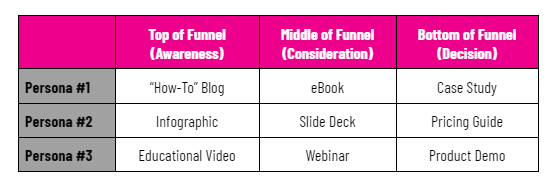Most marketers agree that content marketing should be part of their strategy.
But they often disagree on where it falls in the long list of priorities.
Some say, “It just doesn’t work for our business.”
Others will complain that: “We just don’t have the time to do it.”
However, if you aren’t making content marketing a top priority, you’re missing out on so many benefits:
- Massive boost in website traffic
- High quality leads that deliver a solid ROI
- Higher conversion rates
- More brand elevation
Here’s the good news: it’s never too late to start.
If you’re ready to put your brand out there and start generating results, here’s a brief guide on how to start content marketing in 2021.
What is Content Marketing & Why Do You Need It?
Content marketing is a type of strategic marketing that involves creating and promoting valuable, consistent content to attract a particular audience.
The ultimate goal of content marketing: driving that audience to become profitable customers.
Rather than spend all of your marketing dollars pitching your products or services through advertising, you deliver information that educates the buyer on specific areas that are relevant to your business.
The theory behind content marketing is that if you consistently deliver valuable information to your audience, they’ll reward you with their business.
Yet it can seem counter-intuitive, especially to more traditional marketers who want to drive an immediate purchase.
But the reality is: customers convert and buy products whenever they’re ready.
The key is making sure that, when they decide to buy, you’re their first choice.
Content marketing does this by attracting potential buyers to your website, keeping your brand top of mind, and building up a reputation as a trusted resource in their eyes.
10 Stats Showing the Benefits of Content Marketing
According to HubSpot, 82% of marketers who generate content see a positive ROI from their inbound marketing efforts.
Some specific benefits include:
- 7.8X increase in unique site traffic year-over-year (19.7% vs 2.5%)
- 62% less expensive than traditional marketing and generates about 3X as many leads
- 6X increase in conversion rates vs. non-adopters (2.9% vs 0.5%)
This isn’t surprising, considering that one study of B2B customers showed that 71% reviewed a blog while on their buying journey.
Yet many marketers claim that they’ve “tried content marketing” and haven’t seen results.
In fact, only 42% of B2B marketers report that they’re effective in their content marketing efforts. And content production is the biggest challenge for 44% of marketers.
Typically, this challenge isn’t because content is a bad tactic, but because your business hasn’t brought in the talent and expertise to do it well.
Check out what successful companies are doing:
- 86% of highly effective organizations have someone in charge of content strategy.
- Most effective B2B marketers spend 39% of their marketing budget on content marketing
- 64% of B2B marketers outsource writing
So if you want to be effective at content marketing, you need to prioritize it enough to bring in the resources & experts that will make it a success.
How to Create a Content Strategy
One of the keys to being successful with content marketing is aligning your efforts with your business goals.
If your ultimate goal is lead generation, you’ll need to approach your content in a specific way.
On the other hand, if you want to elevate your brand, you’ll need a slightly different approach.
That’s why content strategy is paramount to your success: It provides a roadmap to get to those goals, and the target KPIs you need to hit along the way.
Here are some questions you’ll need to answer to develop your strategy.
1. What are your goals?
If you start a journey without a destination in mind, you’ll wander around, making no progress in a particular direction.
The same is true for your content.
That’s why you should always start with the end in mind.
What do you want to achieve as a marketer? Here are a few examples:
- Increasing organically-sourced revenue
- Improving lead quality
- Driving more organic traffic
- Elevating brand perception
- Achieving higher search engine rankings.
Once you’ve prioritized one (possibly two) of these goals, you need to add a number to them so you can track your progress:
- Hitting a specific revenue target for the month, quarter, or year
- Increasing lead conversion rates (a sign of lead quality)
- Attracting a certain amount of web traffic each month
- Earning a #1 ranking for certain keywords
2. Who is your target audience?
If you want to create content that will resonate with your audience, you first need to know who you’re talking to.
Your business may have multiple different types of customers (or personas) that you do business with. Each of these personas will likely be interested in different topics or content types.
For example, a C-suite executive will likely respond to shorter, punchier content, while a practitioner will probably want more comprehensive, detailed information.
Additionally, if you’re going to attract people at every stage of the buyer’s journey, you need content for each of those stages:
- Top-of-funnel (TOFU) content makes the reader aware of a problem
- Middle-of-funnel (MOFU) content helps the reader consider solutions to that problem
- Bottom-of-funnel (BOFU) content guides the reader toward deciding to purchase your product
Here’s an example of how to map your content to each of these areas:
This is a basic layout with only nine content assets included. For each cell in the matrix, you can create as many content assets as the persona has questions and problems at that stage of the buyer’s journey.
By clearly identifying your target audience, you can strategically generate content that will guide them as they move toward a purchasing decision.
3. What kinds of content will you create?
In the matrix above, I laid out a number of different content types that you could use to engage each persona.
But just because there are lots of options, doesn’t mean you have to take advantage of them all.
It all depends on who your audience is, and what they’re most likely to consume.
So if you have an audience that you know consumes a lot of video content, that’s where you should put your focus. If your audience consists of avid blog readers, you need to create more blogs.
Eventually, you will want to repurpose your content into as many different formats as possible.
However, when you’re starting out, the best practice is to start small, do those few things really well, then expand from there.
4. Who “owns” your content marketing?
The final piece of your content strategy consists of how you’re going to actually create the content.
Ultimately, this boils down to one question: who is responsible for building and implementing your content strategy?
Because if you don’t have someone to “own” your content marketing, I’ve got news for you.
It’s not going to get done.
So whether you’re looking at an in-house content manager or outsourcing to a content agency, you need one person who you can trust to “own” your content production.
Once you establish that, you’re off to the races.
A Beginner’s Guide to Effective Content Marketing
After you’ve answered those four essential questions, it’s time to put your content strategy into action.
Here are seven steps you and your content manager should take when launching your content marketing machine.
1. Identify your topics.
Perhaps the hardest part of creating content is deciding what to write.
Once you have your strategy in place, however, you already have the foundational pieces that inform what you should generally write about.
Then, you can do focused research to come up with specific topics:
- Atomize the questions in your buyer’s journey matrix. If this sounds complicated, it’s not really. This is simply the process of taking the “big questions” that personas have during the buyer’s journey, and breaking those down into smaller questions that you can address in detail.
- Look at what your competitors are doing. If you have a competitor who is already killing it with their content, take a look at what they’re writing about. While you shouldn’t copy them outright, you can save yourself a lot of work in figuring out what topics your customers are most interested in, since they’ve already done it for you.
- Identify key customer questions. This is especially helpful if you’re recording sales calls and emails in your CRM. Look back on those recordings and write down the questions your customers ask during the sales process. Then generate a piece of content that answers each of them.
- Use a keyword research tool. With most keyword research tools (like Ubersuggest, ahrefs, and SEMRush, among others), you can input a broad topic and it will return a number of more niche keywords within that topic area.
When coming up with content ideas, keep the “Big 5” in mind.
These are the five types of content that, if you remain consistent and honest, will drive the best results for your business:
- Pricing
- “Best of” lists
- Problems (theirs and yours)
- Comparisons
- Reviews
Now, I know that sounds like a lot. So take a deep breath.
If you’re having trouble figuring this out, you may need an experienced content manager to come through and help you walk through the process.
2. Match topics to keywords.
Once you’ve identified the topics you want to write about, the next step is to match those topics to specific keywords.
This is where those keyword research tools I mentioned earlier come in handy. Here are some specific things you should look for:
- Monthly search volume. This will tell you whether the search term is even worth going after.
- Ranking difficulty. This self-explanatory metric is usually directly proportional to search volume.
- Current search results. This will help you figure out if the people searching for that term are at all interested in your solution, or something else entirely.
- Cost-per-click. While this is not the most important metric to look at, it can give you a rough idea of the value of the leads that will come in through this keyword.
While you want a focus keyword for each piece of content, you’ll also want to mix in other keywords as well.
This will help Google realize that you’re a subject matter expert in both the main topic and related topics, boosting your reputation and making it easier to rank in the future.
3. Create your content calendar.
We all know that nothing happens in marketing unless you put a deadline on it.
That’s exactly why you need to take your list of topics and convert it into a content calendar. It should include the following information:
- Title
- Type of content
- Publication date
- Where you’ll promote it and when
Keep in mind that for each piece of content, you’ll want to repurpose it multiple different ways. This could mean breaking up a blog post into several social posts, and combining multiple blogs into an eBook.
Make sure to include all of that repurposed content in your calendar.
When deciding how frequently to post content, the two most important things to keep in mind are consistency and frequency.
If your audience expects you to post every Monday, Tuesday, and Thursday, you need to commit to posting content on each of those days at roughly the same time.
Additionally, when you’re just starting out, you should post content as frequently as possible. This will help you reach your goals faster and quickly build up your online presence.
4. Create your content.
Here’s where the rubber meets the road: you have to actually sit down and write the content (or, get someone else to write it for you).
How long should your content be? While there’s no hard and fast rule, search engines generally favor long-form posts. That’s because they consider them to be more thorough and authoritative.
So the key here is to cover the topic as thoroughly as you can, regardless of how many words that takes. Some topics will warrant 1,000 words, and others 5,000.
One of the tools that can help you during the writing process is a style guide. This will lay out guardrails for your voice, tone, and appearance, and is especially helpful when you have multiple writers working on your content.
Once you draft a piece of content, always let it sit for a day before editing it. It’s also helpful to have someone else come in and provide another set of eyes to point out potential issues that you missed.
Finally, remember to include internal links within your content, using anchor text with relevant keywords for each link.
5. Promote your content.
One of the big mistakes that many companies make is spending a lot of time creating content, and not enough time promoting it.
But if you don’t promote your content, then no one’s going to read it.
Some content promotion options include:
- Email marketing
- Social media posts
- Social media groups
- Influencer outreach
- Guest blogging
- Paid promotion (e.g. PPC, paid social, etc.)
Which channels are best? That depends on your audience.
Taking the time to figure out where your audience spends most of their time will help you choose the best channels to promote your content.
6. Measure your results.
The final step is to gauge the success of your content by measuring results.
Remember those KPIs you established as part of your content strategy? This is the time to see whether you’re hitting those targets.
Many of the KPIs we mentioned earlier are easily trackable through Google Analytics, as well as your CRM.
Keep in mind that content does not generate quick results, especially if you’re just starting out. It can take anywhere from 6-24 months before you’ll realize the full potential of your content strategy.
That said, the faster you publish and promote your content, the faster you’ll get to those results.
On top of that, measuring your content success can help you differentiate between your average content and great content.
Once you get a handle on which content performs best, you can double down on those types of pieces.
How to Conduct a Content Audit
Unless you’re a brand new business or startup, odds are you already have some content out there on the internet.
(If you are starting completely from scratch, feel free to skip this section!)
Most of the time, old content is a neutral force: it’s not hurting you, but it’s certainly not helping you reach your goals.
In some cases, however, that content could be actively hurting your reputation. Especially if it’s thin content, which will result in significant penalties from Google.
Either way, you need to get a handle on what’s sitting on your website and social media platforms so you can make sure that every piece of content is working for you.
This is where the content audit comes in.
Typically, a content audit involves the following steps:
- Logging all the content on your website, including blogs, webpages, downloadable assets, landing pages, etc.
- Identifying which pages are generating results and which ones are stagnant
- Finding gaps in your content to see what you can improve
Let’s take a look at each of these in detail.
Log your existing content.
Screaming Frog is a URL crawler that will log all of your content automatically, and perform the following tasks:
- List URLs
- Analyze page titles and descriptions
- Find duplicate pages
- Create sitemaps
(Also, you can use this same tool to crawl your competitors’ pages. This will help you identify where your competitors are succeeding, and if there are any potential gaps for you to exploit.)
By taking the time to collect all of this information, you’re giving yourself a baseline from which you can start to improve.
See how your content is performing.
Once you know where your content currently stands, you can start to assess how that content is performing.
Some of the more important metrics include:
- Pageviews
- Search rankings
- Backlinks
- Time on page
- Bounce rate
All of this information can give you an idea of how the page is performing, and whether your audience finds it interesting enough to engage with.
If you have content that’s underperforming, you should refresh and update it:
- Make the content more comprehensive and thorough
- Edit the copy to be more readable
- Add internal links
- Tie the content more closely to a specific buyer need
Since refreshing content is easier than writing something brand new, this can be a great “low-hanging fruit” opportunity.
Identify gaps in your content.
Finally, look at your audited content and figure out where there gap. These include:
- Missing keywords
- Customer questions that you’re not addressing
- Middle-ranking content that could be doing better
This information can help you prioritize which content to update or create first.
Final Thoughts on Getting Started with Content Marketing
Having a content marketing strategy and plan is one thing. But if you’re going to make any progress toward your marketing goals, you need to allocate resources to it:
- Internal human resources
- External vendors & partners
- Digital tools & technology
- Paid promotion dollars
Getting a handle on how much time and money you’re investing in content marketing ahead of time will keep there from being surprises down the line.
For instance, let’s say you have a senior executive who wants to review your content before it goes out.
But they think that it’s going to be a 1-hour per week commitment, when it’s actually closer to 5 hours.
Setting that expectation in advance will help them understand how much time they need to allocate (and they may end up backing off once they realize the commitment involved).
This is especially important if you’re outsourcing to a third-party vendor.
You’re likely not going to adopt a “hands-off” approach. You need to still be active in your content production, even if it’s just an oversight role, to make sure it continues to align with your brand and business objectives.
Setting these expectations ahead of time can help you avoid bottlenecks and keep your content machine running smoothly.







